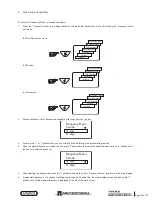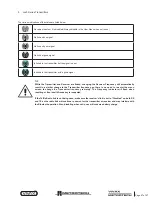
™
Page 67 of 67
8 Glossary
8. Glossary
Active Locate
A locate where a transmitter is used to apply a signal to a buried pipe or cable, the position of which is then located
by a receiver tuned to the same frequency.
Active Signal
A signal applied by the locator transmitter to a buried line. Typical, this is a very precise frequency.
Attenuation
The reduction of an electromagnetic signal from a pipe or cable.
Clamp (or
Coupler)
An accessory used to apply the transmitter signal to an insulated line, removing the need to connect the transmitter
signal directly to a conductor or cable sheath.
Compass
Line direction indicator. (Although visually like a compass, this is the only relation to a compass.)
Coupling
The act of signals transferring to lines to which they were not originally applied. The coupling can be “direct” where
the target line has an electrical connection to another line, or “induced” where the signal radiates from the target line
to another line or lines.
Datalog
Refers to data stored in the memory of the vLoc3 Locator.
Display
The information visually available on the dot matrix display.
Firmware
Permanent software programmed into the vLoc3 read-only memory.
.klm File
Keynote Markup Language (KML) is a file format used to display geographic data in an Earth browser such as
Google Earth, Google Maps, and Google Maps
Line
A generic term for any buried pipe or cable.
Null
A minimum
response to a buried line.
MyLocator3
App created to manage software updates and datalog transfers associated with vLoc3 range of cable locators.
Passive Locate
A locate where the receiver searches for a wide range of signals that radiate from buried pipes or cables. These
signals come from a variety of sources in the environment and couple to the buried (& overhead) lines. Typical
examples 50/60Hz and LF/VLF radio.
Passive signals
A wide range of signals that radiate from buried pipes or cables. These signals come from a variety of sources in the
environment and couple to the buried (& overhead) lines. Typical examples 50/60Hz and LF/VLF radio.
Peak
Maximum response to a buried line.
Pinpoint
Using a receiver to identify the exact position of a buried line.
Response
The indication that the receiver gives which is caused by the signals it is receiving. This can be visual, audio, or both.
Typically, it is displayed on the locator's dot matrix display and audibly from a loudspeaker in the receiver housing.
Search (sweep) This describes the act of looking for a buried line within a given area.
shapefile
The shapefile is a grouping of several files formatted to represent different aspects of geodata:
• .shp — shape format; the feature geometry itself.
• .shx — shape index format; a positional index of the feature geometry to allow seeking forward and backward quickly.
• .dbf — attribute format; columnar attributes for each shape, in dBase IV format.
Sonde
A small transmitting coil which may be built into a product such as a sewer camera or packaged as a small self-
contained battery-powered transmitter. A receiver tuned to the same frequency can locate the position of the Sonde
and hence whatever it is attached to or in. Frequently used for locating sewer cameras, and the non-metallic pipes.
Target Line
The buried pipe or cable to be located.
.txt Text File
A .txt file is a standard text document that contains the unformatted text.
Trace
Using a locator to follow the path of a buried line.
Illustrations used in the preparation of this manual will inevitably show some resemblance to similar illustrations from other
manufacturers. Some manufacturers have given permission for the use of their graphics is given credit for these use. This
statement is intended to attribute such credit.
Disclaimer:
Product and accessory specification and availability information are subject to change without prior notice.




































